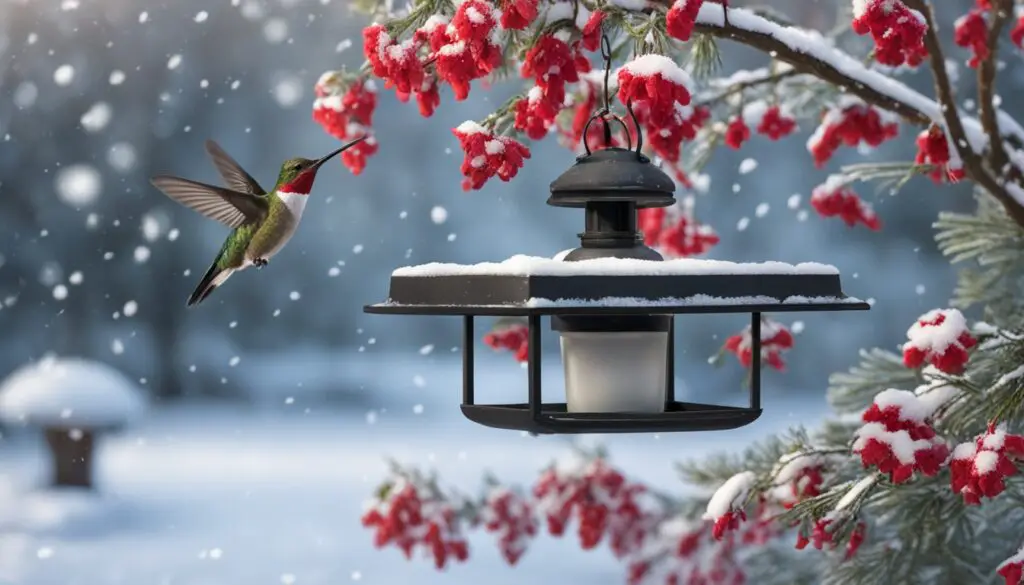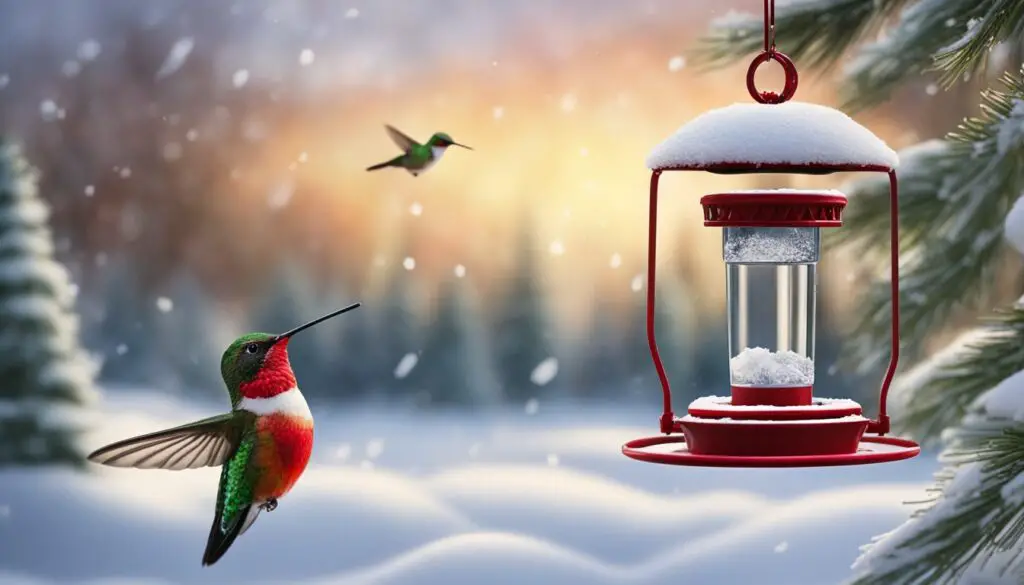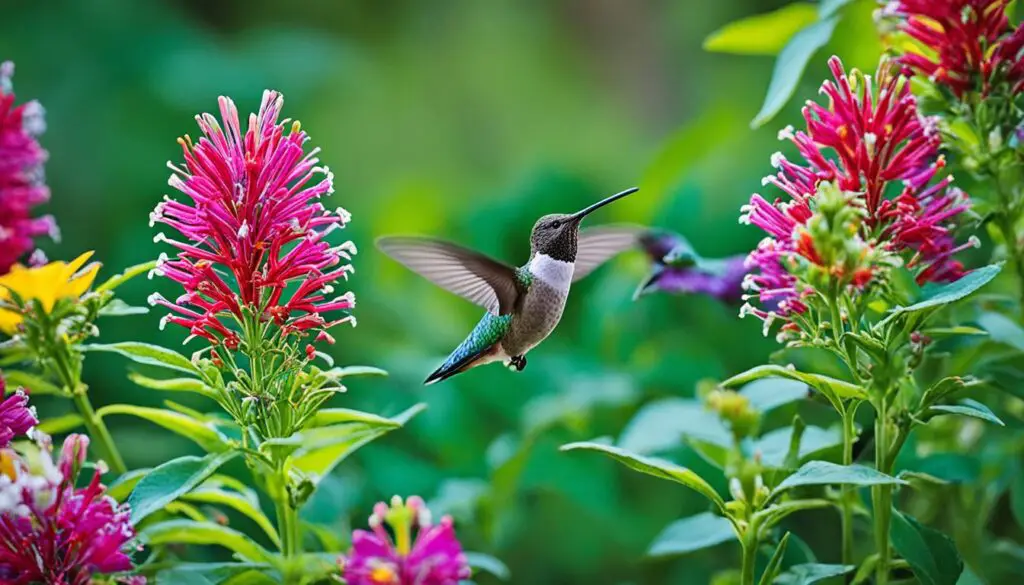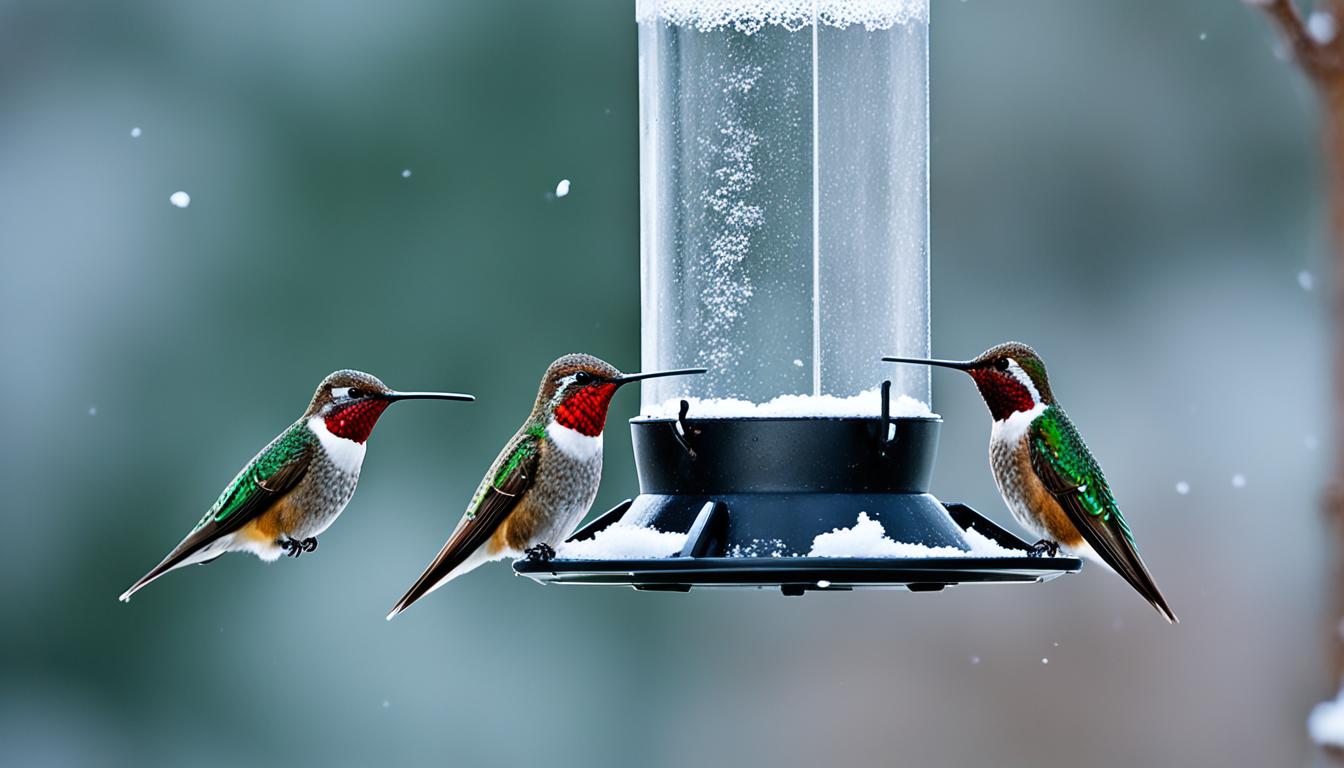Did you know Anna’s hummingbirds in Abbotsford have been growing in number for 10-20 years1? These little birds can handle winter better than we thought. In places like Abbotsford, they’ve found a way to live through the cold1. They’ve also moved to places nearby like Agassiz, Chilliwack, and Harrison1. Their amazing ability to adapt includes eating sap from trees, more bugs, and flowers that bloom in winter1.
Anna’s hummingbirds use torpor to survive the cold, which makes their heart rate and body functions slow down2. This way of saving energy is key for getting through the winter. But, they also need extra food from feeders during these months2. Keeping feeders from freezing and making sure the nectar is safe is important for anyone helping these birds.
To stop the birds from getting too cold, it’s vital to keep feeders warm and unfrozen. Putting feeders in places that shield them from bad weather and bringing them inside at night helps a lot1. By doing these simple things, we can help hummingbirds in winter.
Key Takeaways
- The Anna’s hummingbird population in Abbotsford has been on the rise over the past 20 years1.
- Anna’s hummingbirds have expanded their range to areas like Agassiz, Chilliwack, and Harrison1.
- These hummingbirds adapt to cooler temperatures by feeding on sap, insects, and winter flowers1.
- Utilizing torpor helps hummingbirds conserve energy during cold nights12.
- Keeping feeders ice-free is critical for the birds’ survival during winter months1.
Understanding Hummingbird Migration Patterns
Knowing how hummingbirds migrate is key to helping their species survive. These small birds usually head to Central America or Mexico for winter. They come back north to breed as early as February. Yet, not all of them make this journey3. Take the Ruby-throated Hummingbird, it winters from southern Mexico to northern Panama. It flies non-stop over the Gulf of Mexico for up to 500 miles during its migration4.
Which Hummingbirds Stay During Winter Months?
Hummingbirds are known for their vibrant feathers and their ability to hover in mid-air. These tiny birds are a delight to watch during the warmer months, but have you ever wondered where they go when winter comes? Contrary to popular belief, not all hummingbirds migrate south for the winter. Some species actually stay put in colder regions, braving the chilly temperatures and scarce food sources.
In North America, the most common year-round residents are the Anna’s Hummingbird and the Costa’s Hummingbird. These hardy birds rely on flower nectar and insects for sustenance, even when the weather turns cold. To ensure their survival during the winter months, it is crucial to provide them with suitable habitat and food sources.
Assisting hummingbirds during the winter months goes beyond simply putting up feeders. Providing adequate cover, such as evergreen trees or shrubs, can offer protection from winds and create a microclimate that is slightly warmer. Additionally, maintaining a bird-friendly landscape with an abundance of native flowering plants that bloom all year round can provide a reliable food source for these winter residents.
While it may require some effort, helping hummingbirds during winter months is a rewarding and worthwhile endeavor. Understanding their nesting requirements, maintaining suitable habitats, and creating bird-friendly landscaping can contribute to their survival and bring joy to our own lives as we witness these magnificent creatures thriving even in the coldest of seasons.
The Role of Migration
Migration is vital for hummingbirds. It lets them find the best places to feed and breed all year. They put on 25-40% more weight before migrating. This extra weight helps them keep up their energy3. On their way, they fly at 20-30mph. Their hearts beat up to 1,260 times per minute3. Though there are over 300 hummingbird species worldwide, only 12-15 regularly come to the United States4.
Resident Hummingbirds in the United States
Some hummingbirds, like Anna’s Hummingbirds, stay in the U.S. during winter. They live in Pacific Coast areas where it’s rare to see other hummingbirds3. Backyard feeders give these birds important food. They help them save energy when it’s cold. Bird-friendly yards and native plants also attract hummingbirds during winter, giving them nutrients they need to live.
Impact of Climate Change on Migration
Climate change affects where hummingbirds go in winter. New temperatures can change their migration habits. We need to adjust how we help these birds in winter. Planting native plants and making our yards bird-friendly can give them food3. The Rufous Hummingbird now goes farther north, even to southeastern Alaska3. With these birds eating up to 50% of their weight in nectar during migration, we must change our conservation efforts to support them4.
Feeding Hummingbirds in the Winter
It’s key to feed hummingbirds in winter to help them survive the cold. Keeping their feeders from freezing is a big challenge. There are different ways to stop their nectar feeders from freezing in winter5. You might bring the feeders inside at night or use a light bulb to keep the nectar liquid6. Also, where you place the feeder and how you insulate it matters a lot.

How to Feed Hummingbirds in Winter
To feed hummingbirds in winter, know they need constant access to food. Without food for a few hours, they might starve7. Non-migratory hummingbirds, such as the Anna’s, rely on our feeders. Any stop in food supply can harm them5. Dish-style feeders are better in winter as they’re easier to keep unfrozen than tube feeders5.
Winter Hummingbird Food Sources
Choose winter hummingbird food carefully for their health. Most people make sugar water. The right mix is 1 part sugar to 4 parts water6. Don’t use artificial sweeteners; they’re bad for the birds6. Clean feeders often, like once a week when it’s cold, to avoid infections that can hurt them6.
If you are looking for a great heated hummingbird feeder, please click here!
Sugar Water Ratio for Winter Feeding
The right sugar water mix is crucial in winter. Mix 1 cup sugar with 4 cups of water until sugar dissolves well. This gives them needed energy without harm7. Avoid red dye; it could hurt them7. Clean your feeders often to keep the nectar safe. In warm weather, clean twice a week; in cool, once6. Place feeders in sunny spots. Hummingbirds like bright colors, especially red5.
| Aspect | Detail |
|---|---|
| Sugar Water Ratio | 1 part sugar to 4 parts water6 |
| Cleaning Frequency | Twice per week in hot weather, once in cooler weather6 |
| Prevent Freezing | Bring indoors overnight or use a light bulb near the feeder6 |
| Colors to Attract Hummingbirds | Red and bright colors6 |
By following these care tips, we can support hummingbirds in winter. Offering the right food lets them thrive in our yards.
Winterizing Hummingbird Feeders
It’s important to help hummingbirds during the cold. By keeping their feeders from freezing, you can ensure they always have something to eat. Adding heat sources, insulating, and looking after the feeders every day are great ways. This helps the birds save energy and stay healthy when it’s cold.
Preventing Feeders from Freezing
Stopping feeders from freezing is key. You can bring the feeder inside at night and put it back out in the morning with warm sugar water. This helps avoid brain freeze in hummingbirds1. A light bulb, like a 7-watt in a Hummingbird Hearth Heater, keeps the water from freezing. If it’s really cold, you might need a 15-watt or a 25-watt bulb1. A clamp light attached to the feeder also provides warmth1.

Using Heat Sources and Insulation
For constant nectar access, use heat and insulation. Wrap the feeder in insulating materials, such as wool socks or plumber’s tape1. You can also wrap Christmas lights around the feeder1. These steps prevent the birds from getting too cold and help them save energy during winter.
Daily Maintenance Tips
Keep feeders clean to protect the birds. Use a mix of white vinegar and water (1:4) to clean them5. Change the sugar water every few days to keep it fresh and safe5. Check the feeder’s temperature daily, and switch feeders if they start to freeze. This makes sure hummingbirds have safe, constant food in winter8.
Providing Shelter and Protection
It’s important to give winter hummingbirds a safe place to stay. They need more than just food. Making a bird-friendly space takes planning and effort. We can help these little birds survive the cold by taking care of the space they live in.
Creating a Safe Haven
First, we must understand what hummingbirds need for nesting. They need safe spots away from predators and bad weather. It’s key to have places where they can hide, like thick bushes and trees. These provide cozy spots for them to stay warm.
Choosing native plants helps the environment and gives birds good places to nest. These plants also offer food, making sure hummingbirds have what they need.
Using Native Plants for Cover
Native plants are very important for giving hummingbirds shelter in winter. They cover the birds and give them food. For example, planting flowers that are native to your area can help. These flowers make nectar, even when it’s cold9.
Also, these plants bring insects, which are another food source for the birds. This mix of food and shelter is good for hummingbirds and the environment.
Helping hummingbirds means more than just feeding them. It’s about making a place that keeps them safe all winter. Making your yard friendly for birds helps them and makes our outdoor spaces better. This way, we help the birds and make our gardens lively and full of nature10.
Encouraging Natural Food Sources
It’s crucial to support natural food sources for hummingbirds in winter. Feeders help, but promoting natural feeding habits matters more. This approach benefits the birds greatly.
Planting Flowering Plants
Planting various flowering plants helps hummingbirds. Some flowers offer nectar all winter long. This technique is great for winter gardening and helps native plants.
Adding different colors and bloom times ensures ongoing nectar. This is vital when food is scarce. The Seattle Audubon Society mentions that Anna’s Hummingbirds can even handle snow and cold in Washington if they find food11.

Promoting Insect Availability
Promoting insect availability is key. Insects provide important protein for hummingbirds. By avoiding pesticides, insects thrive, supporting hummingbirds and a balanced ecosystem.
In Central Oregon, temperatures can drop to minus 10 degrees. It’s vital to maintain natural food sources for hummingbirds. Landscaping with native plants allows plants and insects to coexist. This provides balanced nutrition and supports hummingbirds’ feeding habits11.
Conclusion
Helping hummingbirds in winter needs both personal and community effort. Seeing Ruby-throated Hummingbirds breed in the eastern U.S. is important. Especially in Virginia from April to September12. By joining in on citizen science projects like the Christmas Bird Count, we help hummingbirds a lot13.
Making our yards bird-friendly helps hummingbirds find food and safety. Planting native flowers brings more nectar, and insects give them a good diet12. For winter feeding, follow a 1:4 sugar-water mix and clean feeders, says the National Audubon Society13. This turns our yards into safe places for hummingbirds in winter, helping them save energy.
Knowing how hummingbirds move and meeting the needs of Anna’s hummingbirds and others is key. This includes efforts in Virginia and North Carolina12. Community actions and science make our conservation better. Let’s make our places welcoming for these birds all winter and more.
Source Links
- https://langley.wbu.com/hummingbirds-in-winter
- https://realgardensgrownatives.com/?p=678
- https://www.hummingbirdcentral.com/hummingbird-migration.htm
- https://www.perkypet.com/advice/bird-watching/hummingbird-migration/migration-facts
- https://spca.bc.ca/news/hummingbird-feeders-in-winter/
- https://www.audubon.org/news/hummingbird-feeding-faqs
- https://petsonbroadway.com/blogs/expert-advice/the-importance-of-feeding-hummingbirds-throughout-the-winter
- https://www.seattletimes.com/life/lifestyle/qa-winterizing-hummingbird-feeders-overseeding-the-lawn/
- https://www.treehugger.com/how-to-help-hummingbirds-in-winter-5025136
- https://birdsconnectsea.org/2022/12/20/hummingbirds-in-winter/
- https://www.bendsource.com/outside/hummingbirds-in-winter-what-do-we-do-15791462
- http://onthewingva.blogspot.com/2010/10/its-october-should-i-take-down-my.html
- https://ncwaudubon.org/feeding-annas-hummingbirds-during-winter/

My name is Shane Warren, the author behind Your Bird Buddy – your ultimate guide to the wonderful world of birds! Unleash your inner avian explorer as we delve into a vibrant library of knowledge dedicated to all things feathered. From learning about diverse bird species from across the globe to understanding their captivating habitats and behaviors, I’m here to fuel your passion for these magnificent creatures. Not only that, but I also provide valuable insights on being a responsible and informed pet bird owner. Join our vibrant community and let’s celebrate the feathered wonders of the world together – one chirp at a time. And be sure to join our Your Bird Buddy Community over on Facebook!


Comments are closed